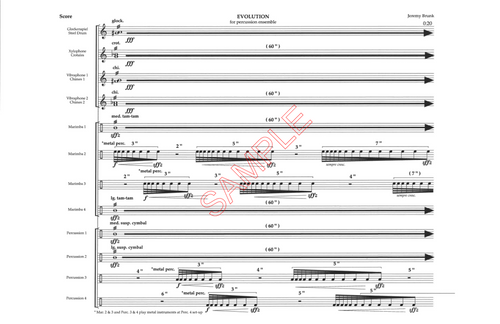Includes score and parts.
Evolution for 12 player percussion ensemble was composed in 2001-2003, written for and premiered by the Millikin University Percussion Ensemble, directed by Brian Justison. The Millikin ensemble presented Evolution at PASIC 2003 in Louisville, KY; and released the premiere recording on its first CD, Best Kept Secret.
Print size: Score: 11 x 17" Parts: Letter (8.5 x 11")
Review from Percussive Notes (2021):
Evolution
Jeremy Brunk
At ten minutes in length, this work for large percussion ensemble centers on ever-developing layers of sound and shifts in timbral focus. It is enthralling to listen to, and every use of chromaticism and orchestrational complexity seems to contribute to this result. While a large number of instruments and players are required, the composer seems deliberate in their employment, avoiding the common pitfalls of many “everything plus the kitchen sink” pieces.
The piece opens with a minute-long “wall of sound” created by tremolo and staggered spatially notated decelerando gestures. This is followed by various sections that feature extensive hockets between instruments, the overlay of asymmetrical rhythms across multiple instruments, and juxtaposition of sustained and rhythmic sounds. The final minute of the piece consists of an unwinding of all the accumulated tension and energy, ending with a final unison statement from the keyboard percussion voices.
Despite the complexity of the resulting sounds when performed together, the individual parts are not profoundly difficult. That being said, performers must be comfortable navigating quintuple and septuple rhythms, as well as their broken subdivisions, independently of other players. An understanding of spatial notation will also be required. For these reasons, it would be difficult to see this work performed without a conductor, as the use of a “traffic cop” would aid greatly in coordinating the many gestures that need to sound intuitive and improvisatory, yet intentional. “Evolution” is a fascinating piece that deserves repeated listenings and would be appropriate for an advanced undergraduate or graduate percussion ensemble.
--Jason Baker
Demo:







